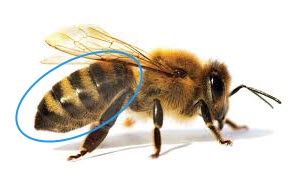Bee that is on top of another bee and is shaking up and down. Very commonly witnessed.
Dorso-ventral shaking is the most common normal behavior one might see. One bee grasps another with prothoracic and mesothoracic legs, and then vigorously and rhythmically shakes its abdomenabdomen:
the segmented, posterior (third) part of the bee body that contains heart, honey, stomach, intestines, Malphigian tubules, reproductive organs, and sting in an up-and-down motion for 0.9 to 1.5 seconds. Receiver bees may remain still or mimic the movement. Such vibratory movements (devaving or DVAVing, also termed "shaking dance") are thought to be a solicitation of hive mates for grooming or for hive activities such as relieving foragers of nectar or swarming preparations, both of which are likely when forager-age bees do the shaking. An interpretation is that the behavior is a "wake-up call," a signal to "prepare for greater activity."
in an up-and-down motion for 0.9 to 1.5 seconds. Receiver bees may remain still or mimic the movement. Such vibratory movements (devaving or DVAVing, also termed "shaking dance") are thought to be a solicitation of hive mates for grooming or for hive activities such as relieving foragers of nectar or swarming preparations, both of which are likely when forager-age bees do the shaking. An interpretation is that the behavior is a "wake-up call," a signal to "prepare for greater activity."
waggle dancing (see bee dancing), which involves side-to side motion repeated several times, while DVAVing is one bee shaking another. Other random bee movements may resemble this movement.
Ramsey M, Bencsik M and Newton MI. 2018. Extensive Vibrational Characterisation and Long-Term Monitoring of Honeybee Dorso-Ventral Abdominal Vibration signals. Scientific Reports 8: 14571. https://www.ncbi.nlm.nih.gov/pmc/articles/PMC6167329/
Collison C. 2016. A Closer Look: Sound Generation and Hearing. Bee Culture. Accessed 2023. https://www.beeculture.com/a-closer-look-sound-generation-and-hearing/
Bencsik M and Ramsey M. 2018. We discovered more about the honeybee ‘wake-up call’ — and it could help save them. The Conversation. Accessed 2018. https://theconversation.com/we-discovered-more-about-the-honeybee-wake-up-call-and-it-could-help-save-them-105751
Schneider S, Stamps JA and Gary NE. 1986. The vibration dance of the honey bee. Animal Behavior 34: 377-385. https://www.sciencedirect.com/science/article/pii/S0003347286801051?via%3Dihub